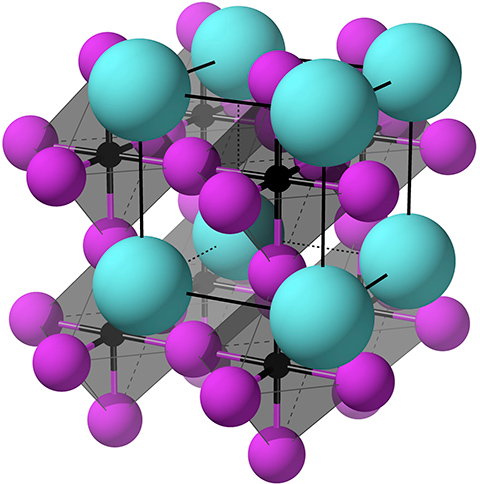NREL Experimental Effort Synthesizes a Previously Theoretical Material
Scientists at the National Renewable Energy Laboratory (NREL) have experimentally synthesized a nitride perovskite that previously only existed in theory and measured its properties in collaboration with researchers at the Colorado School of Mines.

The crystal structure of the new LaWN₃ nitride perovskite shows lanthanum (La) atoms in blue, tungsten (W) atoms in grey, and nitrogen (N) atoms in purple.
Making the nitride perovskite a reality opens the possibility of its application as a material for microelectromechanical devices used in telecommunication and other areas. Nitride perovskites have been computationally predicted to be stable, but few have been synthesized, and their experimental properties remain largely unknown, the researchers pointed out in an article published in Science.
The co-authors of the paper, “Synthesis of LaWN3 nitride perovskite with polar symmetry,” are Kevin Talley, Craig Perkins, and Andriy Zakutayev of NREL’s Materials Science Center, as well as David Diercks and Geoff Brennecka of Mines’ Department of Metallurgical and Materials Engineering. In addition to synthesizing this new perovskite—lanthanum tungsten nitride (LaWN3)—as a thin film, the scientists examined its piezoelectric properties. Piezoelectric materials convert applied pressure into electrical voltage and the other way around—an important property for filters and resonators used in cell phones.
“The most important accomplishments of this research are that this synthesized LaWN3 is one of the first nitride perovskites experimentally reported, and that it has strong piezoelectric response compared to other nitride materials or oxide perovskites,” Zakutayev said. “This successful LaWN3 synthesis means that many other theoretically predicted nitride perovskites should be also possible to synthesize, and that their exciting predicted properties could be used for practical applications.”
Nitrides are formed when metallic elements combine with nitrogen. Zakutayev and other researchers have discovered the possible existence of hundreds of nitrides that had not been synthesized, and experimentally realized some of them. His initial work on the topic led to additional funding from the U.S. Department of Energy’s Office of Science through the Early Career Research Program to understand how to better control experimental synthesis of nitride materials, which supported this nitride perovskite work.
The successful synthesis of LaWN3 suggests that other nitride perovskites with useful properties should also be possible to synthesize. This is important because nitride materials are already revolutionizing the telecommunications and other industries. For example, radio-frequency transistors based on gallium nitride semiconductors and tunable filters based on aluminum nitride piezoelectrics have become an important part of 5G communication technology. The researchers noted that the synthesis of this and other nitride perovskites would likely impact not only fundamental research involving nitride materials discovery, but also applied development of new electronic and energy technologies.
This research was funded by the U.S. Department of Energy’s Office of Science, Basic Energy Science, Materials Chemistry Program.

